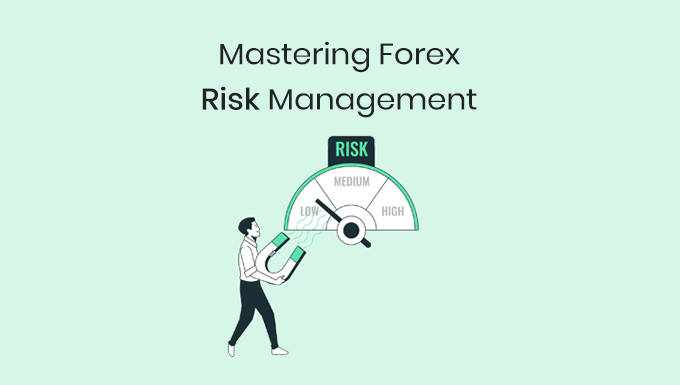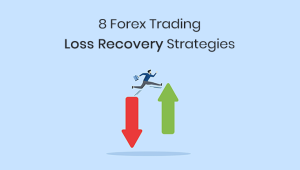There are many ways to make money in the world of forex trading, but it also comes with its fair share of risks. To excel in this competitive environment, traders must understand and manage these risks effectively. This complete guide will explain what forex risk management is, forex risk management techniques, and how to create an effective risk management plan in forex trading. This will help you deal with the challenges and increase your chances of success.
Table of Contents
• Different Types of Risks in Forex Trading
• Effective Forex Risk Management Techniques for Traders
• The Role of Forex Trading Psychology in Risk Management
• Advanced Forex Risk Management Strategies
• Diversification and Portfolio Management in Forex Trading
• How to Develop an Effective Forex Risk Management Plan?
• Effective Forex Risk Management Plan Examples
• Monitoring and Reviewing Your Forex Risk Management Plan
• Real-life Examples and Case Studies of Successful Risk Management
• The Importance of Continuous Learning and Adaptation in Risk Management
• Conclusion
What is Forex Risk Management?
Risk management in forex trading refers to the process of identifying, assessing, and mitigating potential losses associated with currency trading. It involves a combination of strategies, techniques, and tools designed to help traders minimize the impact of adverse market movements on their trading capital. Effective risk management is crucial for long-term success in forex trading, as it helps traders preserve their capital and maintain a sustainable trading approach.
Different Types of Risks in Forex Trading
1. Market risk
This is the risk of suffering losses due to fluctuations in currency exchange rates. Market risk arises from factors such as economic releases, geopolitical events, and changes in market sentiment.
2. Liquidity risks
Liquidity risk arises when traders cannot enter or exit positions at desired price levels due to insufficient market participants willing to trade at those prices. In highly liquid markets, such as major currency pairs, this risk is generally low. However, in less liquid markets, like exotic currency pairs, liquidity risk can be higher.
3. Leverage risk
Leverage allows traders to control larger positions with smaller amounts of capital, amplifying both potential profits and losses. While leverage can enhance returns, it also increases the risk of substantial losses that can exceed the initial investment. Proper risk management is crucial when using leverage in Forex trading.
4. Counterparty risks
This risk involves the possibility of your broker or counterparty defaulting on their obligations, leading to losses on your open trades or an inability to withdraw funds. Traders should carefully choose forex brokers, ensuring they are regulated and reputable, to minimize this risk.
5. Interest rate risk
Changes in interest rates can cause fluctuations in currency values, as higher interest rates attract foreign investment, increasing the demand for a country’s currency. Traders exposed to interest rate risk may experience losses if interest rates move against their positions.
6. Political risk
Political instability, regulatory changes, or government intervention can cause significant fluctuations in exchange rates. Traders should be aware of political risk when trading currencies from countries with unstable political environments or uncertain economic policies.
7. Psychological risks
Trading psychology plays a vital role in Forex trading success. Emotions, such as fear, greed, or overconfidence, can lead to poor decision-making and undermine risk management efforts. Developing a disciplined trading approach is essential to manage psychological risks.
8. Operational risk
This refers to risks associated with trading infrastructure, such as technical issues, platform malfunctions, or human errors that can impact trading performance.
Effective Forex Risk Management Techniques for Traders
1. Proper position sizing
Position sizing involves determining the appropriate amount of capital to risk on each trade. This decision should be based on the trader’s risk tolerance, account size, and the specific trade’s risk factors. Proper position sizing helps manage overall portfolio risk and prevent excessive losses.
2. Stop-loss orders
A stop-loss order is a tool to limit losses by automatically closing a trade if the market moves against the trader’s position beyond a specified level. Utilizing stop-loss orders is crucial in Forex trading, as it provides an exit strategy and helps manage risk effectively.
3. Take-profit orders
Take-profit orders allow traders to lock in profits by closing a trade when the market reaches a predetermined favorable price level. Setting take-profit orders helps ensure that profits are realized and not eroded by market reversals.
4. Trailing stop orders
A trailing stop order is a dynamic stop-loss order that adjusts as the market moves in the trader’s favor. This allows traders to lock in profits while still giving the trade room to run further in their favor. Trailing stops help protect gains while minimizing the impact of market reversals.
5. Diversification and correlation
Diversification involves spreading risk across multiple currency pairs or trading strategies to reduce overall portfolio risk. Traders should be aware of currency correlations, which represent the degree to which currency pairs move in the same or opposite directions. By diversifying and understanding correlations, traders can better manage risk and avoid overexposure to a single market movement.
6. Limiting leverage
While leverage can amplify potential profits, it also increases risk. Traders should use leverage judiciously, taking into account their risk tolerance, experience, and the specific trade’s risk factors. Using lower leverage or no leverage at all will lower drawdown, which helps manage risk and protect trading capital.
7. Managing open trades
Actively monitoring and managing open trades is essential for effective risk management. Traders should be prepared to adjust stop-loss and take-profit orders, close positions early, or add to positions as market conditions change.
8. Risk-to-reward ratio
Evaluate the potential profit of a trade relative to its potential loss to ensure that your trades have a favorable risk-to-reward ratio.
The Role of Forex Trading Psychology in Risk Management
Emotions and psychology play a significant role in risk management. Fear, greed, and overconfidence can all lead to poor risk management decisions. To overcome these challenges:
- Maintain discipline by sticking to your trading plan, even during challenging market conditions. This will help ensure that your risk management practices remain consistent and effective, regardless of market fluctuations.
- Cultivate a growth mindset, focusing on continuous learning and improvement. Embrace both wins and losses as learning opportunities, and avoid becoming overly attached to individual trades.
- Seek support from fellow traders, mentors, or trading communities to help you navigate the emotional aspects of trading. Sharing experiences and insights with others can provide valuable perspective and encouragement.
- Analyze past trades using a forex trading journal, both successful and unsuccessful, is crucial for improving risk management and overall trading performance.
Advanced Forex Risk Management Strategies
1. Hedging techniques
Use strategies such as currency correlation or options trading to protect your positions from adverse market movements. Hedging involves taking an offsetting position to mitigate the risk associated with an existing trade.
2. Volatility analysis
Understand and track market volatility to make informed decisions about position sizing and stop-loss placement. By analyzing historical and implied volatility, you can gauge the potential for large price movements and adjust your risk management strategies accordingly.
3. Multiple timeframes analysis
Multiple timeframes analysis helps identify high-probability trade setups and better manage risk. Using multiple timeframes can help you spot emerging trends, confirm existing ones, and pinpoint optimal entry and exit points.
Diversification and Portfolio Management in Forex Trading
1. Currency diversification
Trade multiple currency pairs to spread risk across various markets and minimize the impact of a single currency’s adverse movement.
2. Strategy diversification
Employ a mix of trading strategies, such as trend-following, range trading, and breakout trading, to take advantage of different market conditions.
3. Timeframe diversification
Engage in both short-term and long-term trades to capitalize on different market movements and reduce the risk of overexposure to a single timeframe.
4. Portfolio rebalancing
Regularly review and adjust your trading portfolio to ensure that it remains aligned with your risk tolerance and overall trading objectives. This may involve reducing exposure to certain currencies or strategies, or adding new ones to maintain a balanced and diversified portfolio.
How to Develop an Effective Forex Risk Management Plan
1. Assess your risk tolerance
Determine how much risk you’re willing to take based on your financial situation, trading goals, and personal preferences.
2. Establish trading objectives
Set specific, measurable, achievable, relevant, and time-bound (SMART) goals that guide your trading decisions and help you stay focused on your long-term objectives.
3. Develop a trading strategy
Create a trading strategy that includes entry, exit, and risk management rules that align with your risk tolerance and objectives. Be sure to backtest and refine your strategy before implementing it in live trading.
4. Implement position sizing and stop-loss rules
Use appropriate position sizes and stop-loss orders to manage risk effectively. This may involve using fixed fractional or fixed ratio position sizing methods to ensure that your trade size aligns with your account size and risk tolerance.
5. Monitor and adjust your plan
Continuously evaluate your risk management plan’s effectiveness, making adjustments as needed to improve performance and adapt to changing market conditions.
Effective Forex Risk Management Plan Examples
Example 1: Position Sizing and Stop-Loss Orders
A forex trader, John, wants to enter a trade on the EUR/USD currency pair. He has a trading account balance of $10,000 and is willing to risk 2% of his account on this trade. John’s risk management strategy involves using proper position sizing and placing a stop-loss order to limit his potential losses.
Position sizing: To calculate the appropriate position size, John first determines how much he’s willing to risk. Since he’s willing to risk 2% of his account balance, this amounts to $200 ($10,000 * 0.02). Based on his analysis, the distance between the entry price and his stop-loss level is 20 pips. To find the position size, John divides his allowed risk by the stop-loss distance in pips: $200 / 20 pips = $10 per pip.
Stop-loss order: John places a stop-loss order 20 pips away from his entry point to limit his potential loss. If the market moves against his trade by 20 pips, the stop-loss order will automatically close the position, preventing further losses and protecting his trading capital.
By using proper position sizing and placing a stop-loss order, John ensures that his potential loss is limited, keeping his risk in line with his risk tolerance.
Example 2: Diversification and Portfolio Management
Jane is an experienced forex trader with a diverse trading portfolio. Her risk management strategy involves diversifying her trades across multiple currency pairs and trading strategies, reducing the impact of a single losing trade on her overall account balance.
Currency diversification: Jane trades multiple currency pairs, such as EUR/USD, USD/JPY, and GBP/USD, to spread her risk across various markets. This helps minimize the impact of a single currency’s adverse movement on her trading capital.
Strategy diversification: Jane employs a mix of trading strategies, including trend-following, range trading, and breakout trading, to take advantage of different market conditions. By diversifying her strategies, Jane can adapt to various market environments and reduce the likelihood of a single strategy underperforming.
By diversifying her trading portfolio across different currency pairs and trading strategies, Jane effectively manages her risk, reducing the potential impact of individual losing trades and maintaining a more stable trading performance.
Monitoring and Reviewing Your Forex Risk Management Plan
1. Track your trading performance
Use a trading journal to record your trades, analyzing both successful and unsuccessful trades to identify areas for improvement. This can help you uncover patterns in your trading behavior and pinpoint areas where your risk management practices may be lacking.
2. Assess your risk management performance
Regularly review your risk management practices to ensure that they remain effective and aligned with your trading objectives. This may involve evaluating your position sizing, stop-loss placement, and overall risk exposure to identify areas for improvement.
3. Adapt to market changes
Be prepared to modify your risk management plan in response to shifting market conditions, economic developments, or changes in your personal circumstances. This may involve adjusting your stop-loss levels, position sizing, or trading strategy to better manage risk in the face of new challenges.
Real-life Examples and Case Studies of Successful Risk Management
Legendary traders, such as George Soros and Paul Tudor Jones, have consistently emphasized the importance of effective risk management in achieving long-term trading success. Their ability to manage risk through position sizing, stop-loss placement, and diversification has contributed to their consistent profitability.
Learn from these successful traders by studying their trading strategies, forex risk management techniques, and psychological approaches to the markets. By understanding their methods and mindset, you can gain valuable insights that can be applied to your own trading.
Implement the lessons learned from these case studies into your own trading, adapting their strategies to suit your unique circumstances and trading style. This may involve incorporating specific risk management techniques, such as dynamic stop-loss orders or volatility-based position sizing, to improve your trading performance.
The Importance of Continuous Learning and Adaptation in Forex Risk Management
The forex market is constantly evolving, requiring traders to stay updated on the latest developments, trends, and risk management practices. To stay ahead of the curve, invest in your trading education by attending webinars, workshops, and courses, reading books and articles, and participating in trading communities.
Embrace a growth mindset, acknowledging that there is always room for improvement and that ongoing learning and adaptation are critical to long-term success in forex trading. By seeking out new knowledge and staying open to change, you can continue to refine your risk management strategies and improve your trading performance.
Use the feedback provided by your trading journal and performance evaluations to identify areas for improvement and further learning. This may involve exploring new risk management techniques, refining your existing strategies, or developing new skills to better navigate the ever-changing forex market.
Conclusion
Effective forex risk management is the foundation of successful forex trading. By understanding the different types of risks, implementing essential forex risk management techniques, and continuously learning and adapting your approach, you can minimize potential losses and maximize your chances of success in the forex market. Embrace the principles outlined in this guide, and you’ll be well on your way to building a sustainable and profitable trading career.






